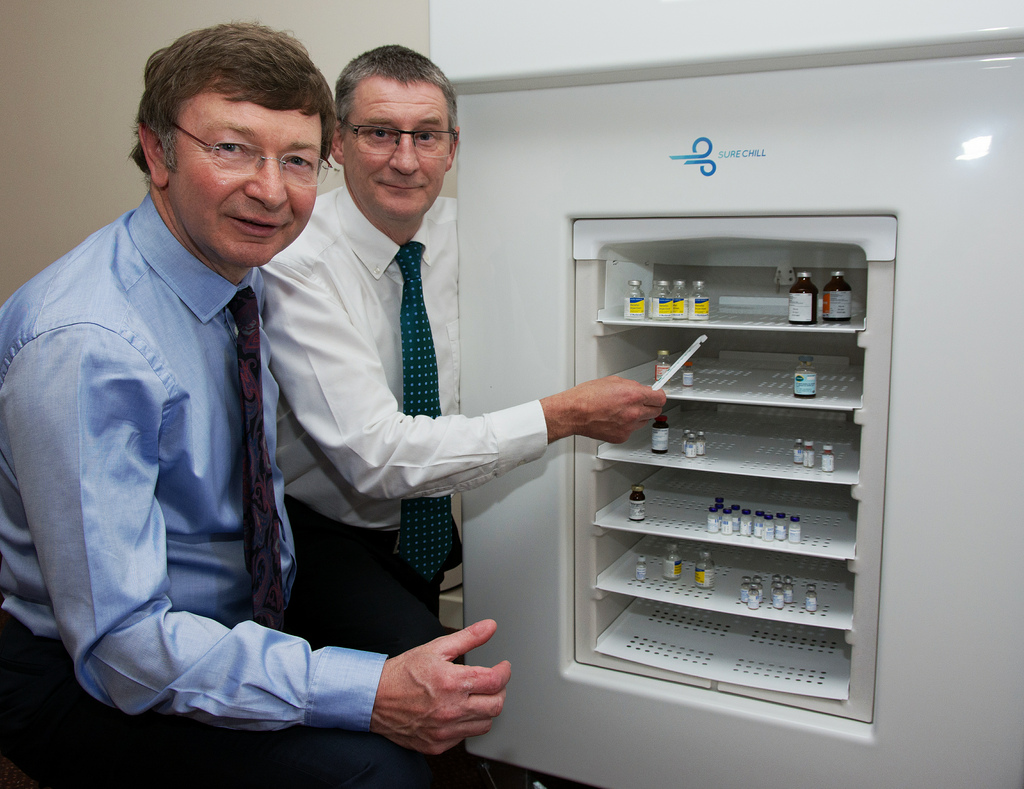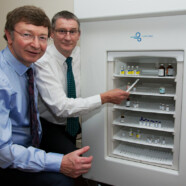This Fridge Doesn’t Need Electricity To Stay Cool
This Fridge Doesn’t Need Electricity To Stay Cool
Inspired by studying frozen lakes, the Sure Chill can stay cold for up to 35 days–long enough to get life-saving vaccines to kids still living off the grid.
Jenny McCarthy might tell you differently, but vaccines really do save lives. Unicef estimates that 2 to 3 million kids survived in 2011 because they were immunized against common diseases and, meanwhile, 1.5 million children died for want of vaccinations.
The biggest problem for aid agencies is to reach the so-called “final fifth”–the roughly 20% of kids worldwide who don’t have ready access to health care. Most of these children are in Africa and Southeast Asia, and most of them come from poor families living in rural areas. To save more lives, the aid community needs to widen the availability of drugs by improving both their transportation and storage into remote places.
A major problem is keeping vaccines cold in areas with no electricity. We’ve covered a few “cold-chain solutions” at this site, including this Gates Foundation-backed “super-thermos,” which keeps vaccines cool even in hot climates. The Sure Chill fridge is something similar, though perhaps even more useful. It’s a full appliance, and it stays cold even when the power goes out or where there’s no power at all.

Sure Chill’s inventor Ian Tansley came up with the idea after studying frozen lakes near his home, and wondering why the top was solid while the water below was still full of swimming fish.
The technology, which comes from a small company in Wales, is based on a fundamental law of physics, as the video below explains. At 39 degrees Fahrenheit (4 degrees Celsius), water is at its heaviest and starts to sink. At any other temperature, it rises. The fridge makes use of this to circulate cold water in a compartment around a central chamber, which stays at a reliable temperature.
When the power is on, the fridge forms an ice layer in a section at the top. When the power goes out, the water starts warming and rises where it’s cooled and falls again. The effect is a virtuous circle that continues until the ice runs out, which can be up to 35 days for some models Sure Chill has developed.
Sure Chill’s inventor Ian Tansley came up with the idea after studying frozen lakes near his home, and wondering why the top was solid while the water below was still full of swimming fish. He wondered how the principle could be applied to regulating temperature in a machine, and started working on a prototype.
The company has since built about 1,500 fridges, including models for the Gates Foundation and Unicef, which is now sending 200 fridges to the Philippines.
Tansley says the fridges “add another link the chain” of cold storage, allowing health workers to deliver drugs to more people. “At the moment, one day a month someone comes with a box of vaccines. If they’re lucky, people will then turn up and get the vaccinations done. But they probably miss a lot of people by doing that because the people are not necessarily in the village that day,” he says. More refrigeration time means more vaccinations potentially.
The fridge is either recharged with ice that comes with the vaccine delivery, or it can re-chilled with a burst of power. With the Filipino project, the fridges are equipped with solar panels that can charge up the machine when the sun’s shining.
In addition to the relatively niche vaccine market, Sure Chill is also looking at other medical fields, like blood and insulin management, and cooling foods and beverages. It already has licensing deals in India and South Africa, and it’s working on others.
The Unicef machines cost $2,600 a time, making them more expensive than standard. But Tansley says the price should fall with larger-scale production. They could even end up cheaper than normal fridges, as they have fewer components and moving parts, and should require less maintenance.
“At the moment, of course, they cost a lot of money because we hand-make them in Wales,” he says. “But once we get into mass manufacture, there should be very little difference from conventional fridges.”
==================================


